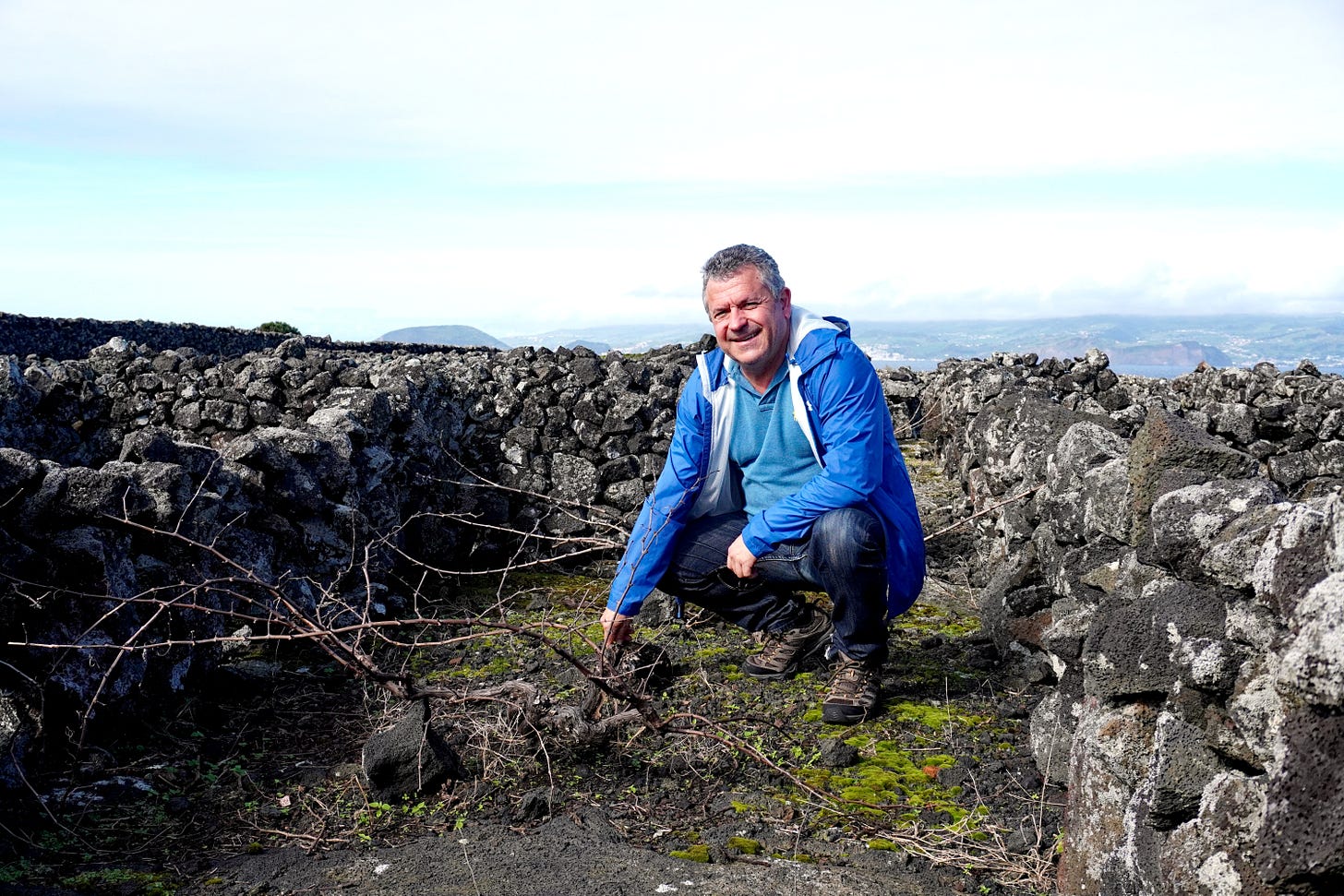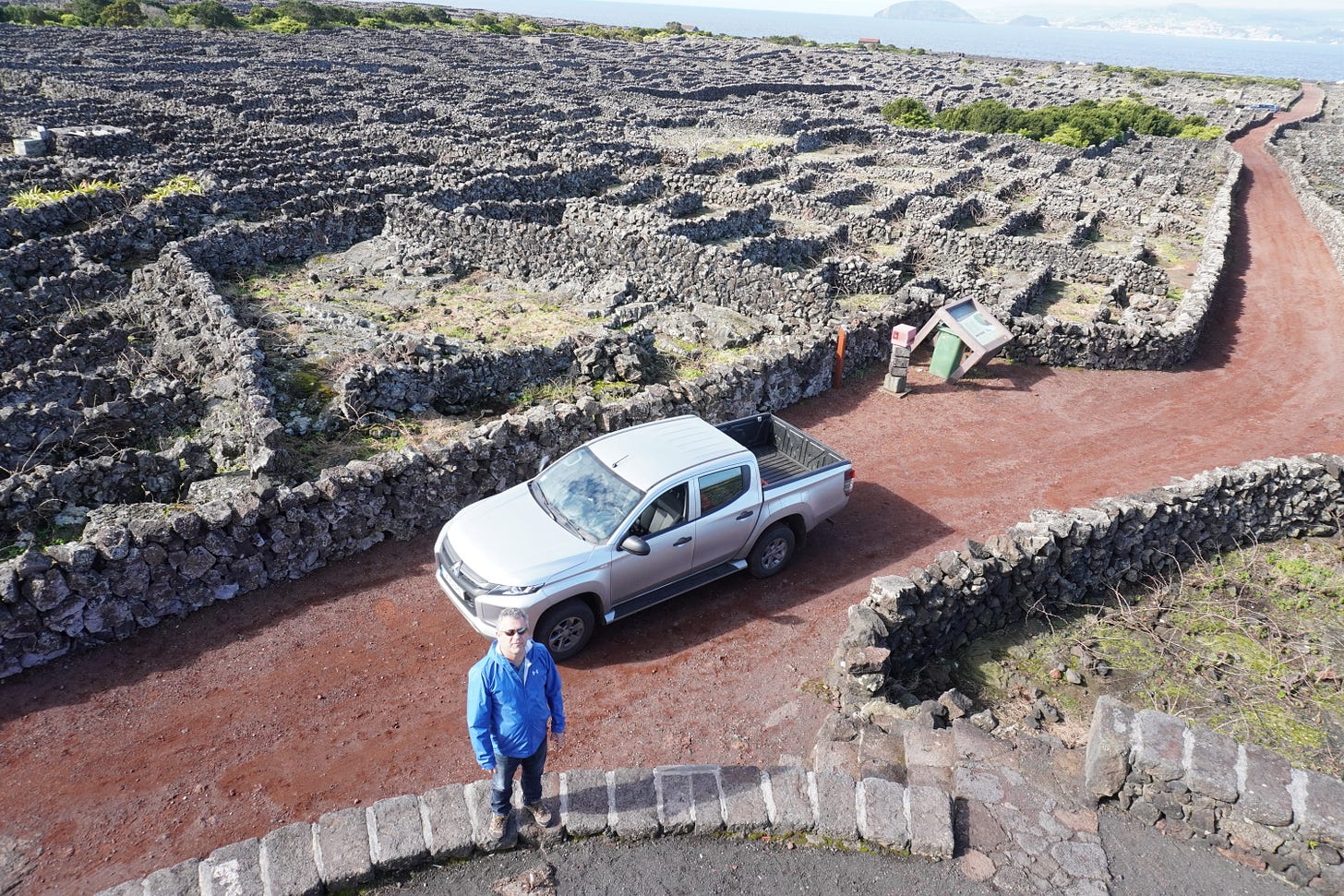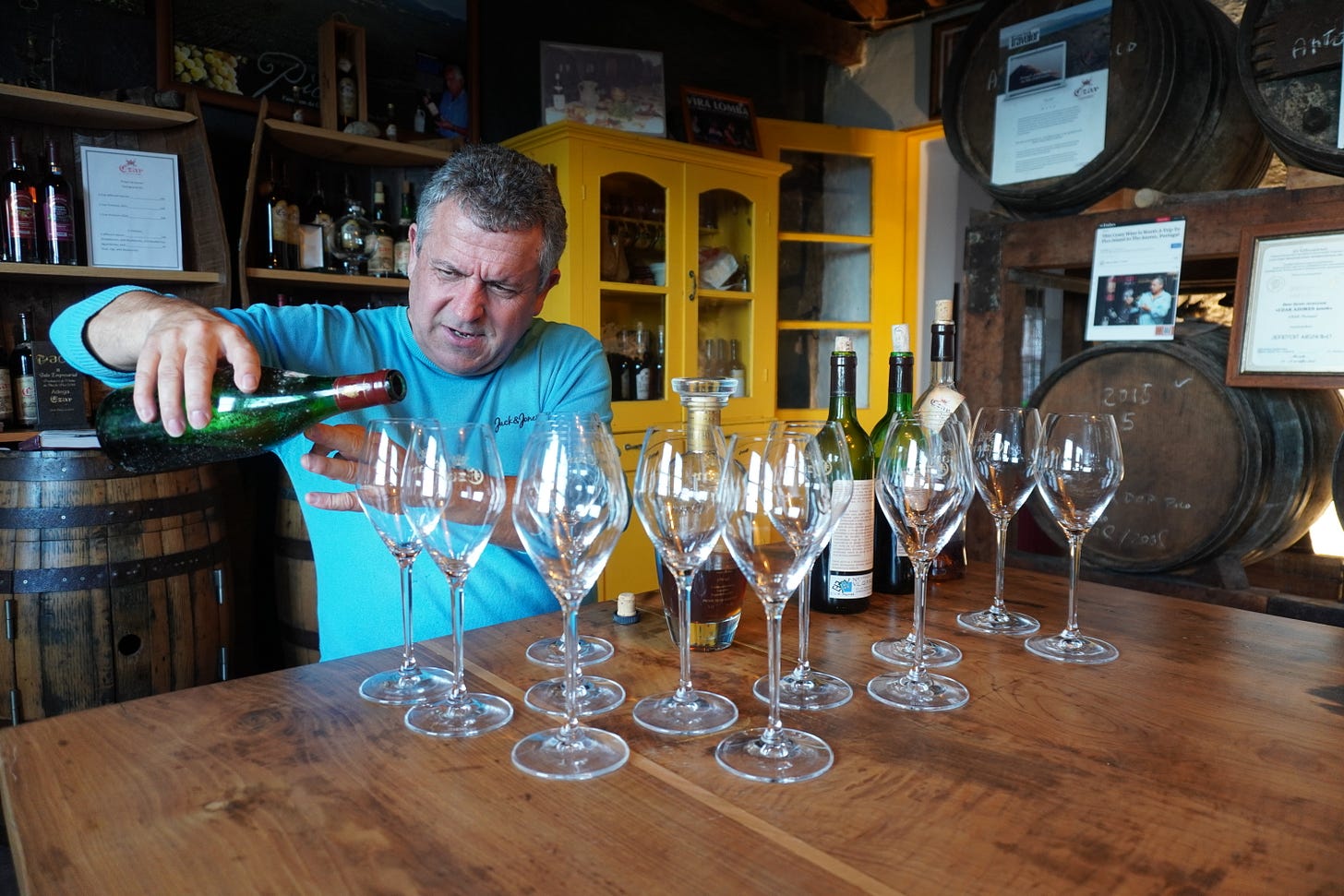Hail Czar!
The €7,500 wine you never heard of, from the Portuguese island of Pico
Fortunato Garcia, a schoolteacher based on the Azores island of Pico, has just spent two hours telling me how his late harvest wine Czar went from €15 a bottle in 2006 to a special release which he’s now pre-selling for €7,500. That’s per bottle. As I wonder if I’m more likely to die of shock or thirst, he opens half a dozen vintages spanning 1991 to 2014 – the current release – and then jumps up to cook dinner. Ever wondered what pairs with a €7,500 bottle? A rustic fish soup made with conger eel, it turns out: caldo do peixe, the island’s speciality, served with bread and a kind of salsa verde. We eat it together with his wife Gina amidst the gloom of the winery’s barrel room – which was briefly the family’s house after the 1974 earthquake.
Confused? I’ll try to explain.
Pico has always been the wine producing hotspot amongst the nine islands of the Azores. Visit and you might wonder how on earth that happened. Pico is covered in black volcanic rock and feels like one of the windiest spots on earth. Vines cling to the ground, surrounded by dry lava stone walls – currais – which protect them from wind and salt spray. By any stretch of the imagination, it’s a tough place to grow grapes.
The oldest vines – up to 150 years old - and some of the most well preserved currais are spread around the village of Criacão Velha. It’s here that Fortunato’s dad Professor José Duarte Garcia (also a schoolteacher) acquired a two-hectare plot in 1962 for the equivalent of five euros. The elderly vendor had just one condition for the sale: José must keep making the island’s traditional pasada wine.
Sometimes referred to as licoroso, aperitivo or just Verdelho (the predominant grape variety), pasada is made from late harvest grapes which are allowed to ferment to 16%, or whenever the yeasts give up. Fortunato maintains that the tradition was never to fortify, though many of the growers who still make pasada for home consumption habitually add a bit of brandy. The result is rich and concentrated but usually not particularly sweet. Both Verdelho and Arinto dos Açores, which often makes up the blend in pasada, have bountiful acidity which concentrates even more as the grapes shrivel on the vine. Up against these Riesling-like acids, the sugars don a cloak of near-invisibility.
Pasada itself is also close to invisible these days, as the island’s recent wine renaissance turned the spotlight on fresh white varietals. It lives on mainly for the locals, although Pico’s cooperative winery makes an excellent fortified licoroso. But back in the 1800s, Pico’s pasada production was sizable, dwarfing the output of its island cousin Madeira. Stories of pasada being passed off as Madeira’s eponymous fortified nectar are legion. Madeira was so well loved at the time that Thomas Jefferson and the founding fathers famously toasted the signing of the US Declaration of Independence with it in 1776. Fortunato has his own take on that. “I have a theory that the Declaration of Independence might have been toasted with Pico wine,” he suggests audaciously, adding that “two out of three barrels of ‘Madeira’ at that time were probably Pico pasada.”
The Russian oligarchy also developed a taste for pasada, and there are records of large quantities being shipped to St Petersburg in 1820. This history inspired José Duarte to christen his wine ‘Czar’ and create the gothic logo which Fortunato still uses today. He started selling small amounts in the 1970s, although the family consumed the lion’s share. By the early 2000s, Czar was the only traditionally made pasada still in existence. José Duarte continued to make it with around three years of ageing in old barrels (not topped up) before bottling.
Fortunato started actively working for his father’s hobby business in 1989, but his ambitions were of a different order. He recalls his father saying, “you know Fortunato, we have the best wine in the world.” To which Fortunato would reply, “yes, only the world doesn’t know it.” If it was the best wine in the world, why did his father worry that even €15 was too a high a price? After José Duarte passed away in 2007, Fortunato’s desire to honour his legacy only intensified. The Russians came into play again in 2011, when he entered Czar in the Moscow International Wine Fair Competition. It won gold, causing a flutter of press in Portugal, and the immediate sale of the last remaining 400 bottles at Fortunato’s upgraded price of €30.
Realising he’d let it go too cheap, Fortunato pushed the price of the 2008 up to €80. It was released after five years in barrel, as Fortunato noted that the longer Czar spent in wood, the better it tasted. In 2019, he released the 2013 after six years ageing. This time the price was €120.
All this time, Fortunato was subsidising production from his teacher’s salary. Even though he now has four hectares of vines, the late harvested yields are so pitifully low that a typical year’s production might be only 1,200 litres. The angel’s share is substantial, and getting more so as Fortunato has now pushed his ageing regime to nine years. An optimum year for Czar sees fermentation continue very slowly for perhaps a year or more, gradually reaching around 19% alcohol (If you’re incredulous about how that can happen with wild yeasts, join the club). If this doesn’t happen, there is no Czar, and the vintage will be declassified. Only five years in the last decade produced the goods. The pricing starts to make sense.
Fortunato still wasn’t making money at €120 a bottle. Famed Portuguese wine journalist João Paulo Martins visited the cellar in 2020. He tasted the 2013, paused, and then suggested changing the plain Bordeaux bottle and increasing the price to €500. Perhaps it was meant as a joke. Fortunato didn’t take it that way. He put his entire remaining stock of the 2013 back in barrel then contacted glassmaker Vista Alegre and asked them to come up with some bling. He rebottled and then sold the 2013s for €490 a pop. The revamped Czar bottle certainly makes a statement with its decanter-like curves, oversized glass stopper and engraved branding. Whether it speaks to you may depend on whether you happen to be a Russian oligarch.
At key moments like this, Fortunato tells me, he would come and sit in his father’s chair at the long table in the barrel room and talk to his dad. More prosaically, he also started phoning his son – who lives in the US – for commercial advice. They benchmarked prices against other high-end wines and came up with the idea of a super-premium release. One barrel of the 2009 remained in the cellar. It had fermented to an extraordinary 20.1% natural alcohol – a current world record.
Vista Alegre created a yet more glitzy container. The resulting cut crystal bottle, with gold leaf engraving and a fancy beaded doodah on top, looks like an oversized perfume vial. It went on sale for €980. After the quick sale of the first 25 bottles, Fortunato raised the price to €1,200. The rest were snapped up. Czar finally turned a profit in 2022.
Fortunato also had several 25 litre flagons of his father’s favourite vintage – 1999 – remaining. He decided that this “last Czar of the 20th century” would be his second special release. Vista Alegre this time came up with a kind of winged decanter creation. The cost of the bottle and packaging is so prohibitive that it can only be offered as a presale. There will be just 86 bottles, each individually engraved with the name of the owner. Fortunato and his son arrived at €7,500 by researching Portugal’s most expensive wines. Deciding that even Czar 1999 couldn’t match an €11,000 bottle of Madeira from the 19th century, they instead price matched it against a one-hundred-year-old ‘VV’ Port. Fortunato must close 20 pre-sales before he can afford to pay for the bottles. Let’s hope it works out.
“I think my dad would be happy to see Czar being sold for such high prices,” he tells me. I feel conflicted. Throughout our interview, he stresses how both his dad and he always loved to see the table full of people enjoying themselves. There’s a long tradition of hospitality and inclusivity in this house. And I can’t help wondering if José Duarte would have preferred to see the bottles being consumed and enjoyed, rather than sold off as luxury items.
Czar is undoubtedly very special. Unlike Madeira, which gets 90% of its interest from ageing and oxidation, Czar starts with top quality late harvested grapes and there is no veil of fortification. Oxidation plays a role, but the concentration and complexity are something else. Depending on the vintage, it can taste smoky and dark like the 1999, or more fruit driven and salty like the 2014 – which might just be the best Czar I’ve yet tasted. There is always spell-binding acidity and Atlantic salinity. It’s a great and truly unique wine. But is it worth €500 – or even €7,500? If you need to ask, you’re probably not in the target market.
Here’s a tip: when Fortunato has visitors to the cellar who can’t afford to buy a bottle, he sends them to the cooperative to buy a bottle of their 10-year-old licoroso (€50). If you want to taste the real deal, be warned: Fortunato tells me that he’s already thinking about raising the price of the new vintage to €1,000. Don’t wait.
Originally published in Noble Rot issue 35.





